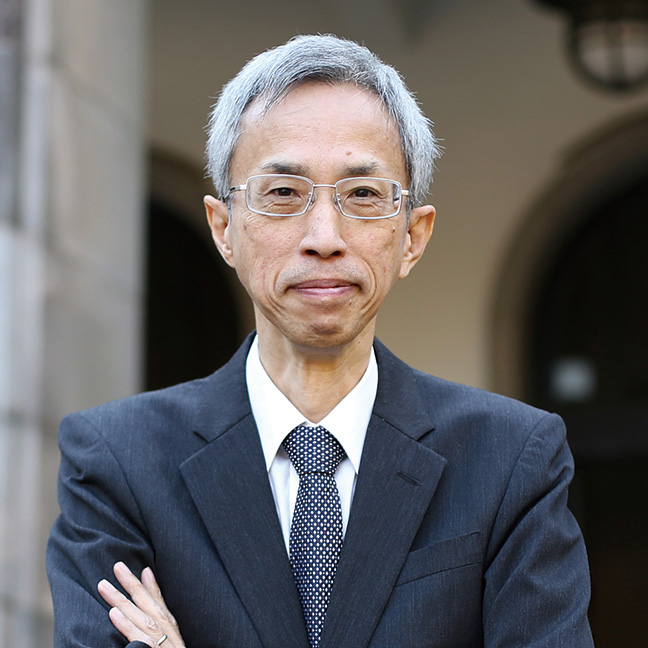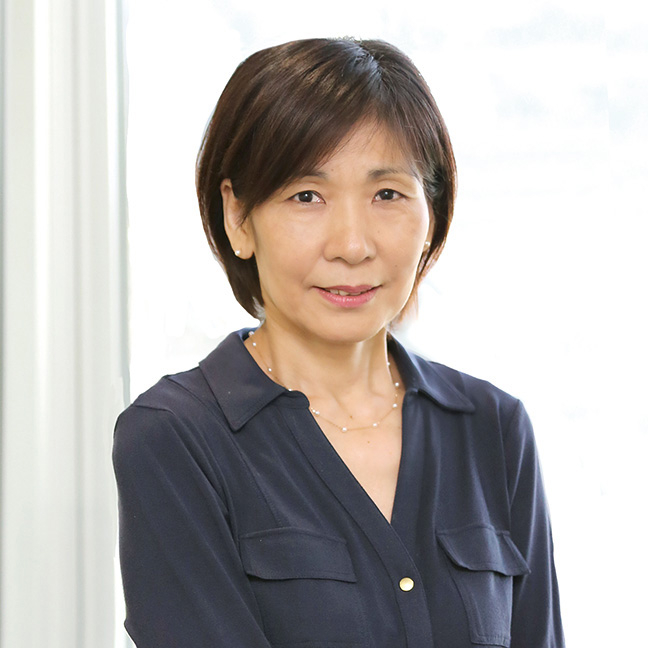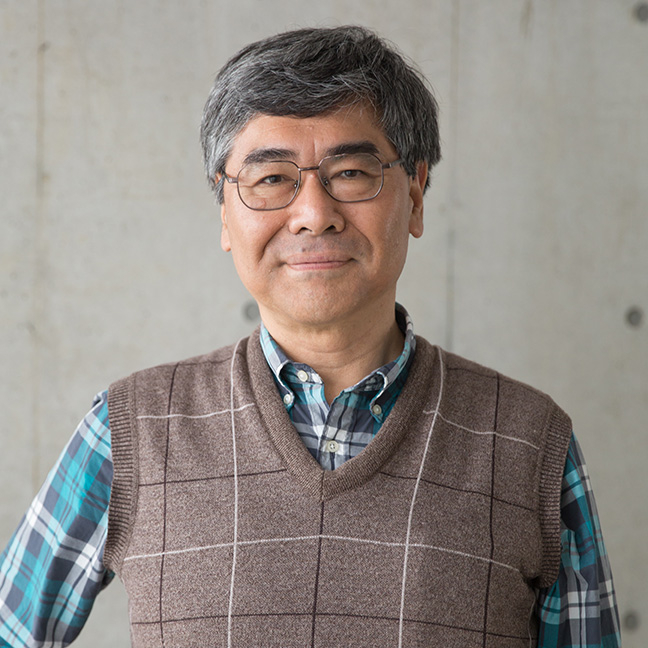It has been about 100 years since the introduction of quantum mechanics revolutionized the field of physics. Over the past few years, a new research field has arisen at Tokyo Tech called "quantum science and technology." Using the entire breadth of the Institute's strengths, the field focuses on supporting society through the practical application of quantum science and technology. But what exactly is quantum science and technology and why are we talking about it? We interviewed the Dean of the School of Engineering, Nobuyuki Iwatsuki, who plays a central role in promoting the advancement of this exciting field. We also introduce highlights of Tokyo Tech's cutting-edge research in the area of quantum science and technology.
Tokyo Tech is focusing strongly on quantum science and technology. Can you tell us what quantum science and technology is and why it is attracting so much attention?
Iwatsuki: Covering the properties of both particles and waves, a quantum is a very small unit of matter or energy. In terms of matter, the main players are atoms and the smaller particles that make up atoms: electrons, neutrons, and protons. Photons and elementary particles such as neutrinos, quarks, and muons are also quanta.

Dean of the School of Engineering, Nobuyuki Iwatsuki
The quantum world defines properties at the nano-scale (1x10-9 m) or smaller. In such an extremely small world, Newtonian mechanics1 does not apply. Instead, it is ruled by these curious laws of quantum mechanics. Quantum mechanics was developed about 100 years ago. It had a significant influence not only on physics, but also on philosophy, raising questions about the meanings of matter and measurement.
Quantum science and technology is a multidisciplinary field concerned with quantum behaviors and mechanics. It not only increases our understanding of nature, but it also allows us to influence phenomena at the quantum level. This ability will lead to the improvement of people's quality of life and the advancement of society as a whole. Micro-focused technology has seen rapid and widespread growth over the past 10 years, and this has been a major factor in increasing the momentum to promote quantum science and technology.
What can quantum science and technology achieve that existing methods cannot?
Iwatsuki: Quantum behaviors include wave-particle duality2, quantum superposition3, and quantum entanglement4. Technology using wave-particle duality has been put into practical use in electronic circuits and other areas. The unique behaviors of superposition and entanglement have been confirmed, and their applications have expanded.
Harnessing quantum behaviors could provide advances in various areas, including information transmission, medical care, the environment, and energy. They could address issues regarding accuracy, sensitivity, capacity, energy conservation, and security. These advances would reach well beyond the limits of existing technology, supporting our future social and industrial infrastructures.
Can you give us some specific examples of applications?
Iwatsuki: The Japanese government's Quantum Science and Technology Committee established roadmaps for quantum science and technology in four categories. These four categories are quantum information processing, quantum measurement and sensing, ultrashort pulse lasers, and next-generation laser processing.
Quantum information processing involves quantum computers and simulations. If quantum computers can be brought into practical use in the next five to ten years, we will see dramatic improvements in both quality and quantity far beyond what current technology can achieve. Reduction of environmental load to ease traffic congestion, decreased costs through shipping automation at plants and storehouses, and renewable energy through high-efficiency solar panels.
Quantum measurement and sensing focuses on development of quantum sensors. For example, they could allow us to measure bioelectric signals non-invasively and at room temperature (unlike MRI, which requires helium cooling). They could be used to detect magnetic field changes related to heartbeat and electrical activity in the brain. We may be able to develop a portable sensor to measure human thought in real time, or sensors that are highly sensitive, compact, and energy-efficient. They could be used to acquire big data for use in the internet of things (IoT5), which is essential to our goal of realizing a super smart society6.
Ultrashort pulse lasers are lasers with pulse widths measuring tens of attoseconds (10-18 s). This technology may allow us to observe electronic states and to better understand chemical reactions and physical properties. This would contribute greatly to drug discovery.
Next-generation laser processing is an aim to develop one-stop technology that is both accurate and economical. That could revolutionize manufacturing and distribution systems.
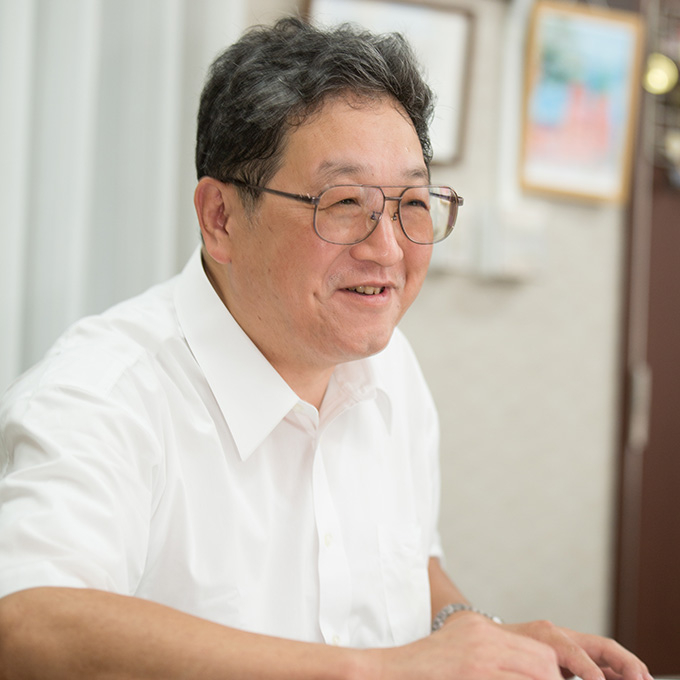
Iwatsuki: At Tokyo Tech, we are confident that the adoption of quantum science and technology into society will lead to new value. With its wide range of achievements in quantum science and technology, Tokyo Tech can make important contributions to society.
In one example, the "quantum annealing machine" commercialized by a venture company in Canada in 2011 was adopted by Google and NASA. The basic principle of this quantum annealing was established in 1998 by Professor Hidetoshi Nishimori at the Institute of Innovative Research. Professor Shinya Koshihara at the School of Science received the Humboldt Research Award for the development of novel materials utilizing a quantum beam. Professor Mutsuko Hatano and Associate Professor Takayuki Iwasaki at the School of Engineering are engaged in research on solid quantum sensors, and Professor Mikio Kozuma at the School of Science is working on quantum simulation and quantum inertial sensors using cold atoms. This is the world's most advanced research for this field. Professor Kozuma is also a program manager for the JST-Mirai Program, which began in 2017. Many scientists are engaged in basic research on quantum mechanics at the School of Science.
On October 22, 2018, Tokyo Tech established the Super Smart Society Promotion Consortium  to promote the development of quantum science and technology and advance its adoption in society in order to realize a super smart society. It is a university-wide hub organization integrating members from the School of Engineering and School of Science and other schools in Tokyo Tech. It will also bring members from a wide range of industry fields. Through this endeavor, we will identify innovative solutions to achieve sustainable development goals7, promote the realization of a super smart society, and increase overall health and longevity.
to promote the development of quantum science and technology and advance its adoption in society in order to realize a super smart society. It is a university-wide hub organization integrating members from the School of Engineering and School of Science and other schools in Tokyo Tech. It will also bring members from a wide range of industry fields. Through this endeavor, we will identify innovative solutions to achieve sustainable development goals7, promote the realization of a super smart society, and increase overall health and longevity.
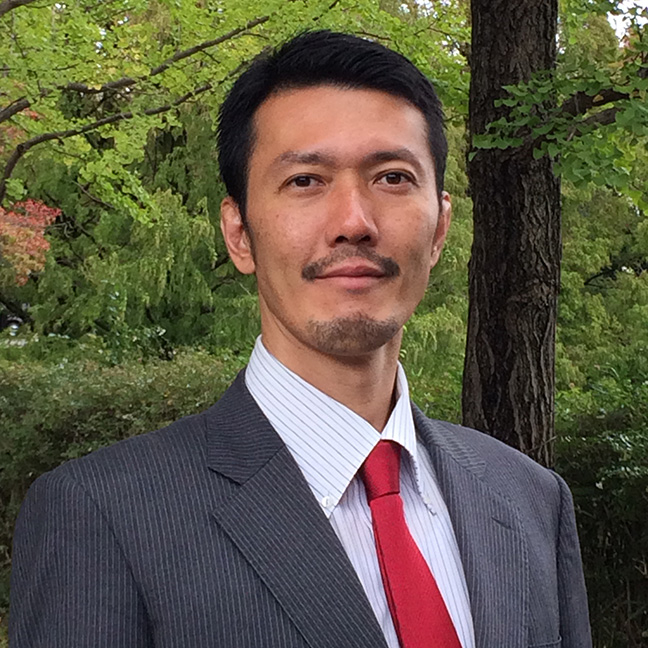
The JST-Mirai Program was launched in November 2017, and among its large-scale projects, Professor Mikio Kozuma leads a study on "Quantum inertial sensor technologies leading to innovative high precision and downsizing of self-localization units."
Accelerometers, which measure acceleration, and gyroscopes, which measure angular velocity, are referred to as inertial sensors. Displacement is acquired by double integration of accelerometer data over time (with accumulating error), and changes in angular velocity are acquired by integrating gyroscope data over time. By combining accelerometers and gyroscopes, a device can determine its location independently and without relying on external signals. This process is known as self-localization.
In Japan, the quasi-zenith satellite "Michibiki," which is capable of centimeter-level accuracy, is being readied. A lot of new industries are expected such as self-driving cars, road pricing, IT agricultural systems, surveying and construction optimization, disaster reporting, human safety confirmation, self-driving snowplows, and marine resource exploration. Self-driving cars and marine resource exploration in particular are major applications. However, the signal generated by the satellite degrades around high-rise buildings and elevated bridges, and is significantly dampened underwater. In order to realize Michibiki's wide range of applications, it is essential to supplement satellite positioning with self-localization units using inertial sensors. This can be easily understood from the fact that aircraft safety has been guaranteed by combining GPS and self-localization units.
The accuracy of self-localization systems using inertial sensors is currently limited by gyroscopes. The gyroscope with the highest performance at present is a ring laser gyroscope (RLG), which utilizes optical interference. However, the RLG does not have enough performance to realize the above-mentioned applications. By replacing the use of light waves with that of quantum waves from laser-cooled atoms (creating a de Broglie wave interferometer), Kozuma's team is working to develop a gyroscope capable of much higher performance than existing models.

A diagram of a gyroscope using de Broglie wave interference*
An interferometer is created by branching, bending, and combining a de Broglie wave of atoms using lasers. When the system is at rest, atoms are emitted to the right. When the system is rotated, the interference of de Broglie wave changes, and the direction to which atoms are emitted changes. Detection of this change allows for realization of a high-performance gyroscope.
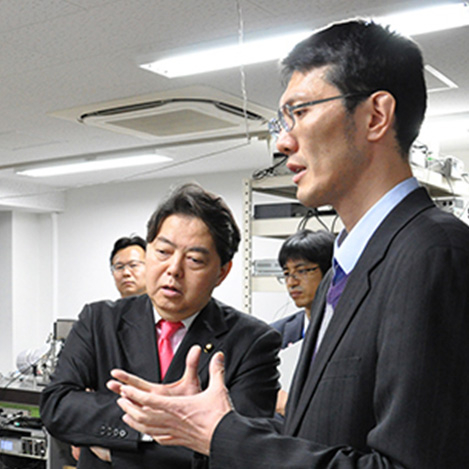
Kozuma answering questions from then minister Yoshimasa Hayashi
*de Broglie wave: Also called a matter wave. In quantum mechanics theory, particles with mass (m) and velocity (v) behave like a wave with a wavelength equivalent to h/mv, where h is Planck's constant
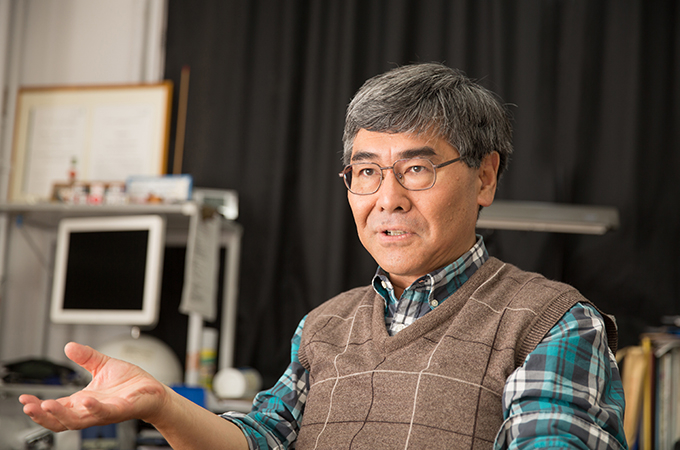
Photoinduced phase transition refers to a change in the state of materials in the blink of an eye through simple exposure to light. This phenomenon is of great interest to global researchers because it has the potential to lead to the realization of never-before-seen photoelectric devices with ultrafast and low-energy systems as alternatives to electronic devices.
1 Newtonian mechanics
Newtonian mechanics is a set of universal principles developed by British scientist Isaac Newton using the laws of motion as its foundation. It is also called classical mechanics to distinguish it from the quantum mechanics used in quantum science and technology.
2 Wave-particle duality
Every particle or quantic entity can be described simultaneously in terms of both particles and waves. Measurement of matter reveals the properties of particles. However, until measurement is performed (such as electron location), there is a probability that the particle or quantic entity exists as a wave.
3 Quantum superposition
The wave that describes the quantum mechanical state of a substance is a probability wave. Until the actual measurement, we only can know the probability of a state (for example, to the right or left from the surface upon which an electron exists) among multiple distinct states. Thus, a quantum state can be represented as a collection of simultaneous distinct states.
4 Quantum entanglement
When measuring the state of a substance at the small scale where quantum mechanics are observed, one of the probable states appears. When measuring the state at a location and determining its properties, the properties of a particle a large distance away are also immediately determined. This phenomenon that links the state of particles separated by a large distance is called quantum entanglement.
5 Internet of Things (IoT)
IoT is the network of a wide range of devices (things) that control themselves through information exchange via the internet.
6 Super Smart Society (Society 5.0)
A human-oriented society capable of realizing economic growth and solving social issues through the implementation of quantum computers and AI into a system in which cyberspace (information) and physical space (the real world) are highly integrated via a communication network.
7 Sustainable Development Goals (SDGs)
SDGs are a collection of global goals to be achieved between 2016 and 2030 that were set by the United Nations General Assembly in September 2015 and included in "Transforming our World: the 2030 Agenda for Sustainable Development." They were developed to succeed the Millennium Development Goals (MDGs) established in 2001. The SDGs include 17 goals and 169 targets intended to eradicate poverty and realize a sustainable world. SDGs are universal goals applicable not only to developed countries, but also developing countries, and the pledge that "No One is Left Behind" through the implementation process. Japan also proactively supports realization of the 2030 Agenda.
United Nations website
. Any information published on this site will be valid in relation to Science Tokyo.




